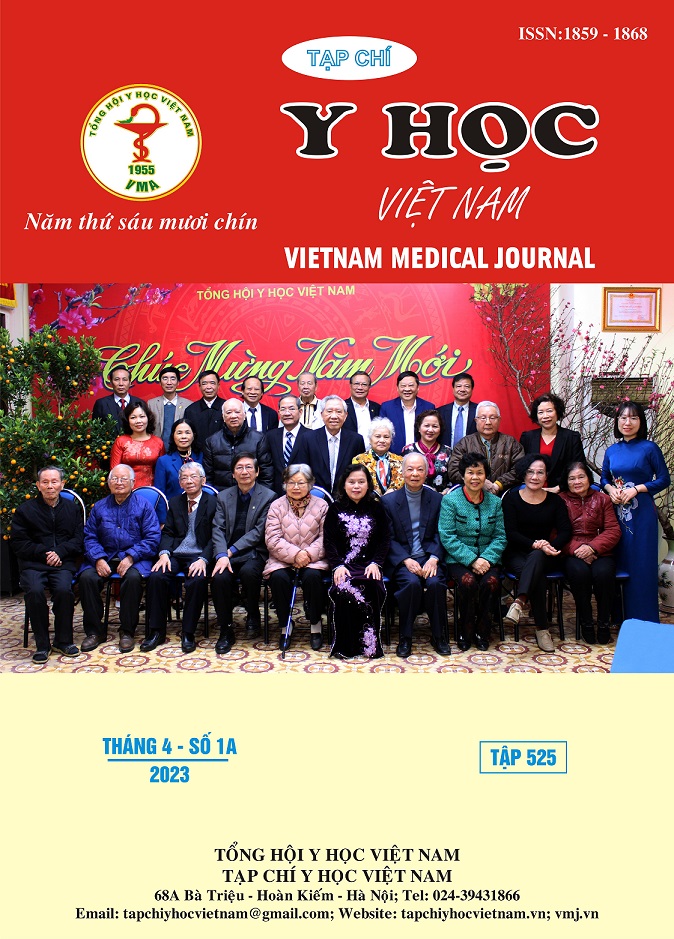SOME FACTORS RELATED TO SURGICAL OUTCOME OF PRIMARY INTRACEREBRAL HEMATOMA
Main Article Content
Abstract
Objectives: Describe some factors related to surgical outcome of primary intracerebral hematoma. Methods: A cross-sectional descriptive study. Results: 61 patients with cerebral hemorrhage were surgically treated at Bach Mai hospital from August 1, 2019 to June 30, 2020. The male/female ratio is 3: 1; The majority of patients with intracerebral hemorrhage are middle-aged, especially between 50 and 69 years of age. The majority of patients had large and medium hematomas (95.1%), 65% of patients had hematomas mainly in the cerebral hemispheres and ventricles. 63.9% of patients were operated by craniotomy to collect hematoma, 3.3% had ventricular drainage alone and 32.8% of patients had ventricular drainage combined with hematoma. Most of the patients recovered almost all of the hematoma (67.2%). After surgery, the number of patients with good and slow progress was 23% and 77%, respectively, no patients died. Glassgow score at hospital admission, hematoma location, degree of midline compression are related to surgical results of primary intracerebral hematoma (p<0,05). Conclusion: The percentage of patients with good results after surgery is still small. Glassgow score at hospital admission, hematoma location, degree of midline compression are related to surgical results of primary intracerebral hematoma
Article Details
Keywords
cerebral hemorrhage, surgery, ventricular drainage, hematoma collection
References
2. Nguyễn Quốc Lâm (2003). Đánh Giá Các Yếu Tố Ảnh Hưởng Đến Kết Quả Điều Trị Phẫu Thuật Máu Tụ Trong Não Do Tăng Huyết Áp. Tạp Chí Y Học Thanh Phố Hồ Chí Minh, 8(1), 63-66.
3. A. D. Mendelow, G. M. Teasdale, D. Barer và Cs (2003). Outcome Assignment in the International Surgical Trial of Intracerebral Haemorrhage. Acta Neurochir (Wien), 145 (8), 679-681; Discussion 681.
4. Vũ Hùng Liên (2004). Can Thiệp Phẫu Thuật Trong Điều Trị Đột Quỵ. Hội Nghị Khoa Học
5. A. D. Mendelow, B. A. Gregson, p. M. Mitchell và Cs (2011). Surgical Trial in Lobar Intracerebral Haemorrhage (STICH II) Protocol. Trials, 12, 124.
6. A. D. Mendelow, B. A. Gregson, E. N. Rowan và Cs (2013). Early Surgery versus Initial Conservative Treatment in Patients with Spontaneous Supratentorial Lobar Intracerebral Haematomas (STICH II): A Randomised Trial. Lancet, 382 (9890), 397-408.
7. Feng Y, He J, Liu B, Yang L, Wang Y. Endoscopic-assisted keyhole technique for hypertensive cerebral hemorrhage in elderly patients: a randomized controlled study in 184 patients. Turk Neurosurg. Published online 2015. doi:10.5137/1019-5149.JTN.12669-14.0
8. Gui C, Gao Y, Hu D, Yang X. Neuroendoscopic minimally invasive surgery and small bone window craniotomy hematoma clearance in the treatment of hypertensive cerebral hemorrhage. Pak J Med Sci. 2019; 35 (2): 377-382. doi: 10.12669/ pjms.35.2.463
9. Zuccarello Mario, Brott Thomas, Derex Laurent, et al. Early Surgical Treatment for Supratentorial Intracerebral Hemorrhage. Stroke. 1999;30(9):1833-1839. doi:10.1161/01.STR.30.9.1833


